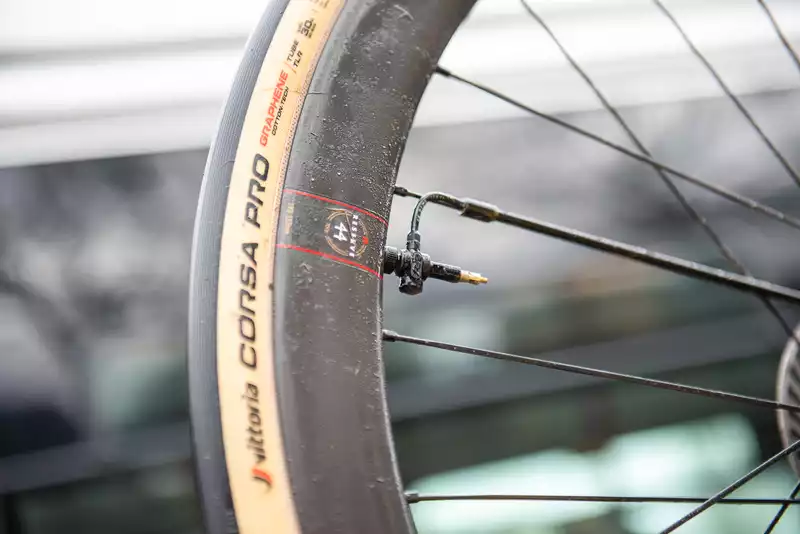It remains to be seen if five-star favorite rider Wout Van Aert will use the innovative "Gravaa KAPS" tire pressure adjustment system in this weekend's Paris-Roubaix.
After the team's reconnaissance run on Thursday, the Belgian rider spoke in an upbeat tone about the injuries he sustained in last week's crash at the Tour of Flanders. But when the conversation turned to innovative tire pressure technology, he kept his cards closer to his chest.
"We'll find out on Sunday who's going to ride," he began.
Called KAPS (Kinetic Air Pressure System), the system was designed by the Dutch brand Gravaa. It claims to allow riders to raise or lower tire pressure on the fly at the touch of a button on the handlebars, via a small motor built into the hub and hoses that run alongside the spokes on either side of the tire valve. There is also another system called Atmoz, used by wheel manufacturer Scope's Team DSM, which has a reservoir of pressurized air in the hub that is similarly released at the push of a button.
On its advantages, Van Aert said, "We are always trying to find new things and this is a great innovation. It allows the rider to run at lower pressure on cobblestones and at normal pressure on pavement.
One of the forces that can slow a rider down is rolling resistance. When riding on a road, bumps and bumps in the road, no matter how large or small, bias the rider's forward force upward as the tire, wheel, bike, and rider are forced to ride up and over the bumps. If the tire can deform around the bump, it can maintain more of its forward momentum and the rider's speed. The lower the tire pressure, the easier it is for the tire to deform over large bumps, but on smooth surfaces, the greater the contact area with the road surface, the greater the friction, and the lower the speed.
On the Paris-Roubaix route, riders regularly move between smooth surfaces and harsh cobblestones, so they must find a balance between the optimal air pressure for smooth roads and the optimal air pressure for cobblestones.
Ultimately, this tradeoff means that tire pressure is not optimal for either. Therefore, the tire pressure adjustment system aims to overcome this problem by allowing riders to easily increase pressure on the road section and to deflate before the rough section.
The Gravaa KAPS system was installed on the bikes of Jumbo-Visma riders after Thursday's reconnaissance run.
When asked why, his response was curt. Of course it's something that will help us. I think it would be a big advantage, but I don't want to give away all the secrets already."
[20However, the Belgian's bike was equipped with the same 54T 1X chainring that he used in Milan San Remo. The change to single chainrings is a trend that will continue until 2023, which may not be so surprising on the flat terrain of Paris-Roubaix.
The flat terrain does not require the easy gearing that a smaller inner chainring brings, and the removal of the inner chainring, along with the removal of the front derailleur, can result in significant weight savings and aerodynamic improvements. In addition, the narrower tooth width of the chainring allows the chain to be held more securely. The addition of a chain keeper further increases safety against chain dropouts, which plagued many teams last season.
Notably, the system has attracted interest from others in the peloton, with Kasper Asgreen (Sourdal-Quickstep) describing it as "very interesting" at the pre-race press conference. 'If it works, it will be a huge advantage.'
.

Comments